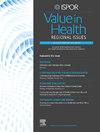自CONITEC成立以来的12年里,罕见肿瘤疾病及其对巴西政府卫生技术的巨大需求:自CONITEC成立以来的12年里,罕见肿瘤疾病及其对巴西政府卫生技术的巨大需求。
IF 1.4
Q3 HEALTH CARE SCIENCES & SERVICES
引用次数: 0
摘要
目标:描述向巴西政府提出的卫生技术需求的特点。方法:通过调查巴西国家卫生技术整合委员会自成立以来至2023年编写的报告,进行了描述性分析。提取的数据按3个领域制表:需求确定、疾病流行病学概况、临床证据和经济评估。结果:813例报告共纳入778例(95.7%),其中266例(34.2%)与罕见病相关。其中,与肿瘤相关的86件(32.3%),其中要求纳入药品的占73.3%,外部需求占51.0%,与公共实体相关的占48.2%,最终意见为建议的占58.7%。合并技术的总增量预算影响和平均增量预算影响分别为36 683 014 441.02雷亚尔和1 111 606 498.20雷亚尔,总增量成本效益比和平均增量成本效益比分别为1 024 897.50雷亚尔和68 326.50雷亚尔/QALY,而非合并技术的成本效益比为3 055 888 437.38雷亚尔;R$ 127 328 684.89;R$ 952 263.85/QALY和;分别为52 903.54雷亚尔/QALY。结论:肿瘤领域在评估需求中具有更大的代表性,罕见癌症代表了卫生技术需求的最大部分,并且决定纳入的大多数。纳入的技术的增量预算影响和增量成本效益比更大,其中2超过了国家卫生技术纳入委员会通过的成本效益门槛。本文章由计算机程序翻译,如有差异,请以英文原文为准。
Rare Oncological Diseases and Their Large Slice in Demands to the Brazilian Government for Health Technologies Over 12 Years Since the Creation of CONITEC
Objetivo
Descrever as características das demandas por tecnologias em saúde submetidas ao Governo Brasileiro.
Metodologia
Foi realizada uma análise descritiva por levantamento dos relatórios produzidos pelo Comitê Nacional de Incorporação de Tecnologias em Saúde (CONITEC) desde sua criação no Brasil até 2023. Os dados extraídos foram tabulados em três domínios: identificação da demanda; perfil epidemiológico da doença; evidências clínicas e; avaliação econômica.
Resultados
Foram incluídos 778 (95,7%) relatórios, dos quais 266 (34,2%) estavam relacionados às doenças raras e, destes, 86 (32,3%) destinavam-se à oncologia, dos quais 73,3% foram pedidos de incorporação de medicamentos, 51,0% de demanda externa, 48,2% relacionados à entidades públicas, e 58,7% tiveram como parecer final a recomendação. O impacto orçamentário incremental total e médio das tecnologias incorporadas foi de R$ 36.683.014.441,02 e R$ 1.111.606.498,20 e a razão de custo-efetividade incremental total e média foi de R$ 1.024.897,50/QALY e R$ 68.326,50/QALY, enquanto para as tecnologias não incorporadas foi de R$ 3.055.888.437,38; R$ 127.328.684,89; R$ 952.263,85/QALY e; R$ 52.903,54/QALY, respectivamente.
Conclusão
A área oncológica teve maior representatividade entre as demandas avaliadas, sendo que os cânceres raros representaram a maior parcela das tecnologias em saúde demandadas e, a decisão de incorporação foi majoritária. O impacto orçamentário incremental e razão de custo efetividade incremental foi maior para as tecnologias incorporadas, duas dentre elas ultrapassaram o limiar de custo-efetividade adotado pela CONITEC.
Objectives
To describe the characteristics of the demands for health technologies submitted to the Brazilian Government.
Methodology
A descriptive analysis was carried out by surveying the reports produced by the National Committee for the Incorporation of Health Technologies since its creation in Brazil until 2023. The extracted data were tabulated in 3 domains: identification of demand, epidemiological profile of the disease, and clinical evidence and economic assessment.
Results
A total of 778 among 813 reports were included (95.7%), of which 266 (34.2%) were related to rare diseases. Of these, 86 (32.3%) were related to oncology, for 73.3% of which there were requests for the incorporation of medicines, 51.0% from external demand, 48.2% related to public entities, and 58.7% had the recommendation as a final opinion. The total and average incremental budgetary impact of the incorporated technologies was R$36 683 014 441.02 and R$1 111 606 498.20 and the total and average incremental cost-effectiveness ratio was R$1 024 897.50/QALY and R$68 326.50/QALY, whereas for nonincorporated technologies it was R$3 055 888 437.38; R$ 127 328 684.89; R$ 952 263.85/QALY and; R$52 903.54/QALY, respectively.
Conclusion
The oncology area had greater representation among the demands evaluated, with rare cancers representing the largest portion of health technologies demanded, and the decision to incorporate was the majority. The incremental budgetary impact and incremental cost-effectiveness ratio were greater for the incorporated technologies, 2 among them exceeded the cost-effectiveness threshold adopted by the National Committee for the Incorporation of Health Technologies.
求助全文
通过发布文献求助,成功后即可免费获取论文全文。
去求助
来源期刊

Value in health regional issues
Pharmacology, Toxicology and Pharmaceutics-Pharmacology, Toxicology and Pharmaceutics (miscellaneous)
CiteScore
2.60
自引率
5.00%
发文量
127
 求助内容:
求助内容: 应助结果提醒方式:
应助结果提醒方式:


